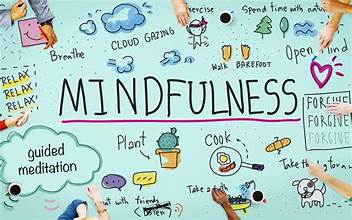Mindfulness, Mindfulness has become a buzzword in recent years, but what exactly does it mean? In simple terms, mindfulness is the practice of being fully present and aware of the present moment, without judgment. It involves paying attention to our thoughts, feelings, and sensations in a non-reactive way. The benefits of mindfulness are numerous, but one of the most significant is its ability to reduce stress.
In today’s fast-paced world, stress has become a common part of our daily lives. Whether it’s work pressures, financial worries, or personal relationships, stress can take a toll on our mental and physical well-being. This is where mindfulness comes in. By cultivating a mindful attitude, we can learn to manage stress more effectively and improve our overall quality of life.
Contents
- 1 Introduction to Mindfulness
- 2 Understanding the Benefits of Mindfulness for Stress Reduction
- 3 The Science Behind Mindfulness: How it Affects the Brain
- 4 Mindfulness Techniques for Living in the Moment
- 5 Mindful Breathing: A Simple Practice for Reducing Stress
- 6 Mindful Meditation: How to Start a Daily Practice
- 7 Mindful Eating: How to Enjoy Your Food and Reduce Overeating
- 8 Mindful Movement: Yoga and Other Practices for Stress Relief
- 9 Mindful Communication: How to Listen and Speak with Awareness
- 10 Mindful Work: How to Stay Focused and Productive
- 11 FAQs
Key Takeaways
- Mindfulness is the practice of being present in the moment and aware of your thoughts and feelings.
- Practicing mindfulness can reduce stress and improve overall well-being.
- Mindfulness has been shown to affect the brain by increasing activity in areas associated with attention and emotional regulation.
- Mindful breathing and meditation are simple techniques that can be used to reduce stress and increase mindfulness.
- Mindfulness can be applied to various aspects of life, including eating, movement, communication, and work.
Introduction to Mindfulness
Mindfulness has its roots in ancient Eastern philosophies and practices, particularly in Buddhism. It has been practiced for thousands of years as a way to cultivate inner peace and wisdom. However, it wasn’t until the late 20th century that mindfulness gained popularity in the Western world.
Today, mindfulness is recognized as a powerful tool for managing stress and promoting well-being. It has been embraced by psychologists, therapists, and even large corporations as a way to enhance mental health and productivity. In a world that is constantly bombarding us with distractions and demands for our attention, mindfulness offers a way to find calm amidst the chaos.
Understanding the Benefits of Mindfulness for Stress Reduction
One of the primary reasons why mindfulness is effective in reducing stress is because it helps us become more aware of our thoughts and emotions. Often, stress arises from our tendency to get caught up in negative thinking patterns or worrying about the future. By practicing mindfulness, we can learn to observe these thoughts without getting entangled in them.
Research has shown that mindfulness can have a profound impact on mental health. Studies have found that regular mindfulness practice can reduce symptoms of anxiety and depression, improve mood, and increase overall well-being. It can also help us develop a greater sense of self-compassion and acceptance, which can be particularly beneficial during times of stress.
In addition to its mental health benefits, mindfulness has also been found to have positive effects on physical health. Chronic stress can take a toll on our bodies, leading to a range of health problems such as high blood pressure, weakened immune system, and digestive issues. By reducing stress, mindfulness can help improve these physical ailments and promote overall wellness.
The Science Behind Mindfulness: How it Affects the Brain
| Metrics | Data |
| Number of studies conducted on mindfulness | Over 6,000 |
| Regions of the brain affected by mindfulness | Pre-frontal cortex, amygdala, hippocampus |
| Effect of mindfulness on pre-frontal cortex | Increased activity and connectivity |
| Effect of mindfulness on amygdala | Decreased activity and reactivity |
| Effect of mindfulness on hippocampus | Increased grey matter density |
| Benefits of mindfulness on mental health | Reduced stress, anxiety and depression |
| Benefits of mindfulness on physical health | Lowered blood pressure, improved immune function |
The benefits of mindfulness are not just anecdotal; there is scientific evidence to support its effectiveness. Numerous studies have been conducted to understand how mindfulness affects the brain.
One of the key findings is that mindfulness practice can lead to changes in the structure and function of the brain. For example, research has shown that regular mindfulness meditation can increase the thickness of the prefrontal cortex, which is responsible for executive functions such as attention and decision-making. It has also been found to decrease the size of the amygdala, which is involved in the stress response.
Furthermore, studies have shown that mindfulness can enhance connectivity between different regions of the brain, leading to improved cognitive abilities and emotional regulation. This increased connectivity allows us to respond to stressors more effectively and make better decisions in challenging situations.

Mindfulness Techniques for Living in the Moment
Living in the moment is a fundamental aspect of mindfulness. It involves fully engaging with our present experience, rather than getting lost in thoughts about the past or worries about the future. By practicing mindfulness in our daily lives, we can learn to appreciate each moment and find joy in simple pleasures.
There are many techniques for practicing mindfulness in daily life. One simple technique is to bring awareness to our senses. For example, when eating a meal, we can pay attention to the taste, texture, and aroma of the food. When walking, we can notice the sensation of our feet touching the ground and the sounds around us. By focusing on our senses, we can anchor ourselves in the present moment and cultivate a sense of gratitude for the here and now.
Another technique is to practice mindful breathing. This involves bringing our attention to the breath and observing it without trying to change it. By focusing on the breath, we can calm our minds and bring ourselves back to the present moment. Mindful breathing can be done anywhere, at any time, making it a convenient tool for reducing stress in our daily lives.
Mindful Breathing: A Simple Practice for Reducing Stress
Mindful breathing is a powerful technique for reducing stress and promoting relaxation. It involves bringing our attention to the breath and observing it without judgment. By focusing on the breath, we can anchor ourselves in the present moment and calm our minds.
To practice mindful breathing, find a quiet place where you can sit comfortably. Close your eyes and take a few deep breaths to relax your body. Then, bring your attention to your breath. Notice the sensation of the breath entering and leaving your body. Observe the rise and fall of your abdomen or the feeling of air passing through your nostrils.
As you continue to focus on your breath, you may notice that your mind starts to wander. This is normal; our minds are naturally restless. When you become aware that your mind has wandered, gently bring your attention back to your breath without judgment or frustration. Each time you bring your attention back to the breath, you are strengthening your mindfulness muscle.
Practicing mindful breathing for just a few minutes each day can have a profound impact on your stress levels. It can help you become more aware of your body’s signals and respond to stress in a more calm and centered way.
Mindful Meditation: How to Start a Daily Practice
Mindful meditation is another powerful technique for cultivating mindfulness and reducing stress. It involves sitting in a quiet place and focusing your attention on a specific object, such as the breath or a mantra. By practicing mindful meditation regularly, you can train your mind to become more focused and present.
To start a daily meditation practice, find a comfortable place where you can sit without distractions. Close your eyes and take a few deep breaths to relax your body. Then, choose an object of focus, such as your breath or a word or phrase that has meaning to you.
Bring your attention to the chosen object and observe it without judgment. If your mind starts to wander, gently bring your attention back to the object. It’s important to remember that meditation is not about stopping your thoughts; it’s about observing them without getting caught up in them.
Start with just a few minutes of meditation each day and gradually increase the duration as you become more comfortable. Consistency is key; try to make meditation a daily habit, even if it’s just for a few minutes. Over time, you will notice the benefits of regular meditation practice, such as increased focus, reduced stress, and improved overall well-being.
Mindful Eating: How to Enjoy Your Food and Reduce Overeating
Mindful eating is a practice that involves bringing awareness and attention to the act of eating. It can help us develop a healthier relationship with food and reduce overeating.
In today’s fast-paced world, we often eat on the go or while multitasking. This can lead to mindless eating, where we consume food without really paying attention to it. Mindful eating encourages us to slow down and savor each bite, allowing us to fully enjoy our food and make healthier choices.
To practice mindful eating, start by creating a calm and peaceful environment for your meals. Turn off distractions such as the TV or your phone, and find a quiet place where you can focus on your food. Take a moment to appreciate the colors, textures, and smells of your meal.
As you eat, pay attention to the taste and sensations in your mouth. Chew slowly and savor each bite. Notice the flavors and textures of the food. Be aware of how your body feels as you eat, and stop eating when you feel satisfied, rather than when you are full.
By practicing mindful eating, you can develop a greater awareness of your body’s hunger and fullness cues. This can help you make healthier choices and prevent overeating. It can also enhance your enjoyment of food, as you learn to savor each bite and appreciate the nourishment it provides.
Mindful Movement: Yoga and Other Practices for Stress Relief
Mindful movement involves bringing awareness to our bodies as we engage in physical activities. It can be practiced through activities such as yoga, tai chi, or simply going for a walk in nature. By combining movement with mindfulness, we can reduce stress and promote physical well-being.
Yoga is a popular form of mindful movement that combines physical postures with breath awareness and meditation. It is known for its ability to promote relaxation, flexibility, and strength. Through yoga practice, we can learn to connect with our bodies and cultivate a sense of inner peace.
Tai chi is another form of mindful movement that originated in ancient China. It involves slow, flowing movements combined with deep breathing and mental focus. Tai chi has been found to reduce stress, improve balance and coordination, and enhance overall well-being.
Even simple activities such as walking can be transformed into a mindful movement practice. As you walk, bring your attention to the sensation of your feet touching the ground, the movement of your body, and the sounds around you. By focusing on the present moment, you can turn a mundane activity into a meditative experience.
Mindful Communication: How to Listen and Speak with Awareness
Mindful communication involves bringing awareness and presence to our interactions with others. It is about truly listening and speaking with intention, rather than being caught up in our own thoughts or judgments.
One of the key aspects of mindful communication is active listening. This means giving our full attention to the person who is speaking, without interrupting or formulating a response in our minds. By truly listening, we can better understand the other person’s perspective and respond in a more thoughtful and compassionate way.
Mindful communication also involves speaking with awareness. Before speaking, take a moment to pause and reflect on what you want to say. Consider the impact your words may have on the other person and choose your words carefully. Speak from a place of kindness and empathy, rather than reacting impulsively.
By practicing mindful communication, we can improve our relationships and create a more harmonious environment. It allows us to connect with others on a deeper level and foster understanding and compassion.
Mindful Work: How to Stay Focused and Productive
Mindful work involves bringing mindfulness into our professional lives. It is about staying focused and present in our tasks, rather than getting overwhelmed by distractions or multitasking.
One of the key aspects of mindful work is single-tasking. Instead of trying to do multiple things at once, focus on one task at a time. Give it your full attention and complete it before moving on to the next task. This can help improve productivity and reduce stress.
Another aspect of mindful work is taking regular breaks. Our brains need time to rest and recharge in order to maintain focus and productivity. Schedule short breaks throughout the day to stretch, take a walk, or simply relax. Use these breaks as an opportunity to bring awareness to your body and mind, allowing yourself to reset and refocus.
Creating a calm and organized workspace can also contribute to mindful work. Clear away clutter, organize your materials, and create a space that promotes focus and creativity. Minimize distractions such as noise or unnecessary notifications, and create a routine that allows you to start and end your workday mindfully.
In conclusion, is a powerful practice that can have profound effects on our well-being. By cultivating a mindful attitude, we can reduce stress, improve mental and physical health, and enhance our overall quality of life.
It’s important to remember that mindfulness is not a quick fix; it is a lifelong journey. It requires commitment and practice to develop the skills of awareness and presence. However, the benefits are well worth the effort.
One of the pioneers of mindfulness in the Western world is Jon Kabat-Zinn. He is a renowned author and teacher who has played a significant role in bringing mindfulness into mainstream society. His work has helped millions of people around the world discover the transformative power of mindfulness.
So why not start practicing today? Take a few moments each day to bring awareness to your breath, your body, or your surroundings. Notice how it feels to be fully present in the moment. With regular practice, you can cultivate a greater sense of peace, joy, and well-being in your life.

FAQs
What is mindfulness?
Mindfulness is the practice of being present and fully engaged in the current moment, without judgment or distraction.
How does reduce stress?
Reduces stress by helping individuals focus on the present moment, rather than worrying about the past or future. This can help reduce anxiety and promote relaxation.
What are some mindfulness techniques?
Some mindfulness techniques include deep breathing, meditation, yoga, and body scans. These techniques can help individuals become more aware of their thoughts and feelings, and learn to manage them more effectively.
Can mindfulness improve mental health?
Yes, mindfulness has been shown to improve mental health by reducing symptoms of anxiety and depression, and improving overall well-being.
How can mindfulness be incorporated into daily life?
Mindfulness can be incorporated into daily life by practicing techniques such as deep breathing or body scans during moments of stress or anxiety, or by setting aside time each day for meditation or yoga.
Is mindfulness a religious practice?
While mindfulness has roots in Buddhism, it is not inherently a religious practice and can be practiced by individuals of any faith or belief system.
To Read More About Mindfulness
To Read About Sacred geometry










